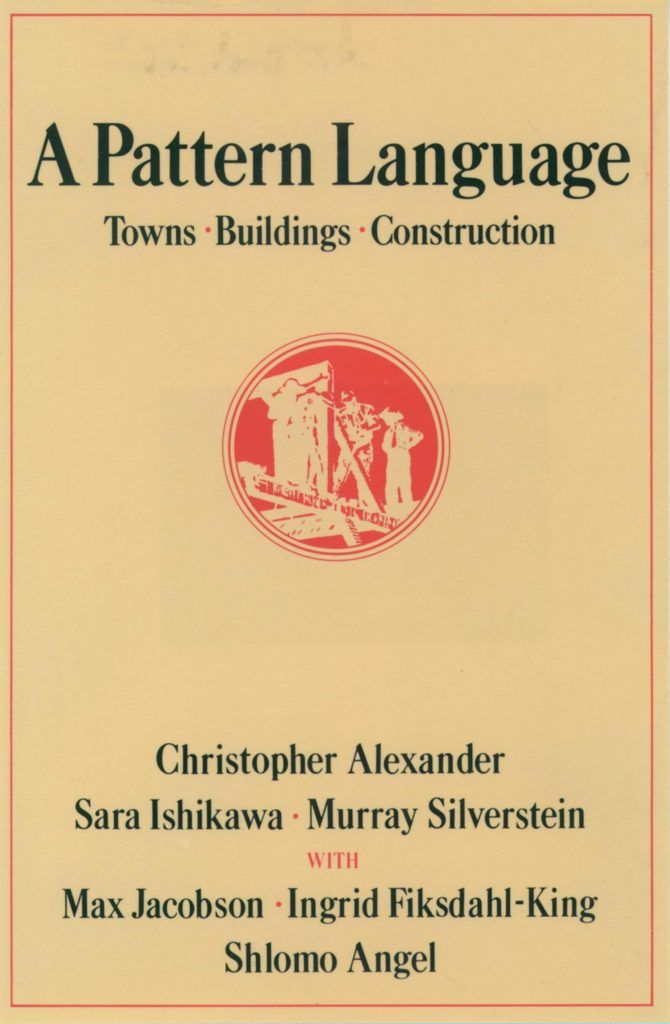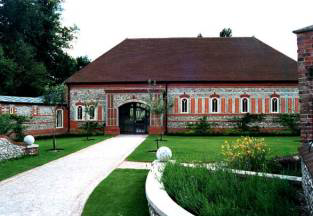A Pattern Language by Christopher Alexander: Review and Notes
A fantastic Guidebook to design thinking which if you use it as an aide rather than a Bible will educate and enrich your designs. Would love to see an updated New Edition.
Introduction

A Pattern Language: Towns, Buildings, Construction by Christopher Alexander, Sara Ishikawa, Murray Silverstein, Max Jacobson, Ingrid Fiksdahl-King, Shlomo Angel
A Pattern Language came out in 1977 authored by Christopher Alexander with some of his students Sara Ishikawa, Murray Silverstein, Max Jacobson, Ingrid Fiksdahl-King, Shlomo Angel.
At the time I believe Christopher Alexander was teaching Architecture at Berkley and the first group of books he wrote sprung from his teaching, research and designing there. It is one of a series of Books by Alexander but A Pattern Language is his most widely read work.
Alexanders books principally A Timeless Way of Building, A Pattern Language and The Nature of Order have inspired a following not just in Architecture but in other fields also principally Computer Science where his work is more influential than in Architecture.
The Author

Christopher Alexander was born in Vienna in 1936 and was brought up in the UK. He first studied Chemistry and Physics before switching to Mathematics and Architecture at Cambridge. He achieved the first ever PHD in Architecture from Harvard. He then taught Architecture at Berkeley.
Overview
The first page begins with a bang,
The books are intended to provide a complete working alternative to our present ideas about architecture, building, and planning—an alternative which will, we hope, gradually replace current ideas and practices.
So to replace the way we design and cities and buildings completely, not short of ambition at all then! The book is the second in a three book series (or was at the time) which has now expanded principle among these is The Nature of Order.
Volume 1 -The Timeless Way of Building
Volume 2 -A Pattern Language
Volume 3 -The Oregon Experiment
Key Ideas
A Key Insight is that Alexander recognises repeated design problems which recur but always in a slightly different way. So for instance how to address the question of the location of a building on a plot of land when the problem is always the same but the conditions always vary.
The Solution is to see these design problems as patterns.
When you realise that all your design problems can be matched to a pattern and that these patterns interlink then you have a kind of language
Hence A Pattern Language was born.
The elements of this language are entities called patterns. Each pattern describes a problem which occurs over and over again in our environment, and then describes the core of the solution to that problem, in such a way that you can use this solution a million times over, without ever doing it the same way twice.
So this book is a kind of Guidebook for choosing and using a set of interlinking patterns with which to help design your city, park, building or kitchen.
What can a student learn from this book, well it’s grounded in basic design facts and keen insights about what buildings are. It’s on a basic level it’s unbelievably practical.
Patterns
After laying out an introduction and explanation of how to use the book the major part of the book is the 253 patterns laid out here.
The first 94 patterns deal with larger scale issues, countries, cities, towns, communities. The next set 95-205 are building patterns. Patterns 206 -253 are construction patterns of the building. So the patterns logically follow in a rough scale twhich assists in choosing and jumping around between patterns.
Another thing to note about the patterns is that Alexander claims a couple of properties about them.
According to Alexander patterns are archetypal in other words they are discovered not created. That there are other Patterns to be discovered and some that may be improved upon. Also there are other pattern languages.
Either way it’s worthy of note that Alexander is making a substantial Metaphysical claim about these design Patterns.
The Timeless Way of Building says that every society which is alive and whole, will have its own unique and distinct pattern language; and further, that every individual in such a society will have a unique language, shared in part, but which as a totality is unique to the mind of the person who has it. In this sense, in a healthy society there will be as many pattern languages as there are people—even though these languages are shared and similar.
Nature of a Pattern
The format of each pattern is standardised and roughly follows these lines;
- Picture of a design problem.
- Archetypal pattern of the solution.
- Text with context.
- Research to back up claims.
- Summary bolded.
- These patterns are also interlinked or backlinked to other associated pattern.
The patterns are mostly a joy and full of practical information to slowly chew over or a quick inspiration reference. Even the ones I found I didn’t agree with helped me think through the reasons for the disagreement and therefore might help clarify something in a design.
Architectural Influence
While the book and many patterns are themselves well loved by Architects Alexanders’ ideas have not really impacted much on mainstream Architectural discourse. This is in some ways slightly surprising as A Pattern Language is often a key text for Architects. But his built work and those of his followers have not really managed to convince the wider urban and building design community that he was really on to anything truly game changing.
His ideas or philosophy have had better success in the New Urbanism movements and in traditional Architectural revival groups such as Prince of Wales’s Institute of Architecture (UK) of which he was a trustee.
Influence Elsewhere
Alexanders work has been influential in a few fields outside of planning and architecture. In fact his works generally have been more influential in the area of computer programing than in any other area.
The greatest influence of A Pattern Language in computer science is the design patterns movement. The Wiki was invented by the Hillside Group to work on programming design patterns. This is only the principal influence of CA’s work on programming, CA’s work has had a lasting and deep philosophical influence on much of programming.
Design Thinking and Note-taking
Personally I was reminded of the work of Alexander by my following of a new set of software tools around note-taking and zettelkasten systems.
Wiki and other emerging note-taking software like Roam Research and Obsidian and to a lesser extent Notion and Bear have begun to look at personal note-taking systems that can manage a great deal of information in a structured way so as to be more easily accessible than a more traditional file and folder system.
The Zettlekasten system recently most notably refined by Nikas Luhmann is having a small renaissance and Alexanders influence through the design patterns group makes him a key thinker to anyone with an interest in this field.
Criticism
The Patterns
This is not so much a criticism but an observation. The patterns published in 1977 are in some places getting a little long on the tooth. The research they sight could do with a little refresh and maybe patterns added and revised to take into account progress and changing needs. There are also some quirks that probably reflect the authors bias which I think they would be the first to own up to.
Also I think many of the presuppositions come from an Anglo-American centric societal bias. Different social spaces may be missing here again something I think the authors would acknowledge, and even encourage further pattern writing.
A book like this if it was published today really would be more useful as a wiki that could be continually edited.
Metaphysical Problems
A bigger problem is Alexanders premise that these patterns are found not made. That is assuming a very big something about the world and about the nature of design problems and solutions.
Alexanders background in the Sciences like Chemistry and Maths where discoveries are made and something about the nature of the world is found may be something to do with why he looks at design problems in the same way.
Alexander was dissatisfied with how people used A Pattern Language he admits himself that the results were average.
Later on with his book The Nature of Order he doubles down on this idea of design patterns as inherent in nature. He talks about Living structure and more fundamental design absolutes to be found that underpin his patterns.
But this might be misunderstanding the nature of design. While it is without question that much of design is underpinned by invariables, the size of the human body and the nature of our interactions for instance, it doesn’t follow that one material organisation of some object is fundamentally more ‘right’ than any other. Also in principle the idea that all design solutions should be the most harmonius seems very simplistic.
A good example of the clash of the view of Alexander with a more wary but open ended view is illustrated by a famous talk or debate that Alexander had with the Architect Peter Eisenmann in a famous debate in 1982.
Alexander vs Eisenmann
Below is something Eisenmann says in reply to Alexander
Let me be more specific. Last night, you gave two examples of structural relationships that evoke feelings of wholeness — of an arcade around a court, which was too large, and of a window frame which is also too large. Le Corbusier once defined architecture as having to do with a window which is either too large or too small, but never the right size. Once it was the right size it was no longer functioning. When it is the right size, that building is merely a building. The only way in the presence of architecture that is that feeling, that need for something other, when the window was either too large or too small. - Peter Eisnmann
In other words Eisenmann through the Corbusier quote defines Architecture in absolutely the opposite terms as Alexander, challenging rather than reassuring.
Moreover in Eisenmans design metaphysics there is at least allowed an open answer, a way of challenging or of comforting and that I think its why Alexanders view became sidelined. It was Peter Eisenmann and other Architects of the time with more similar design philosophies which became more influential.
Style Problems
While A Pattern Language does state that there are no architectural styles, patterns can be assumed to apply to any architectural style equally, it’s notable when you look at the work of Alexander himself or his followers that they fall into a more traditionalist style.
This is probably again due to the problems of metaphysics of his design philosophy. There is by default a bias against the new, looking backwards for patterns as opposed to looking forward to new forms and ways of addressing old problems. This has I believe over Alexanders career tended to box him in as an Architect and isolate him in the profession and he has become a kind of Outsider Architect.

West Dean Visitor Center by Christopher Alexander 1995
The West Dean Visitor Centre is a building which Alexander and his colleagues at The Center for Environmental Structure (C.E.S.) built between July 1994-November 1995 in Sussex, England. The style matches quite much that of the surrounding buildings. It’s worth reading the page about the design of this building to get an insight into the design process here.
Conclusion
There is much in A Pattern Language to love for my part I appreciate the profundidy of some of the Patterns which are insightful and enlightening.
The key idea of creating a web of patterns from these is akin to programming or note taking and conveys a path to design complex things in a coherent way. To be able to assist synthesising your own ‘language’ for a project you have whoever you are.
A student will find a well of great practical advise to be used in a structured way for the whole project. Or if browsing to be able to give inspiration at a flick of a page. It will provide a network of ideas with which you can structure a design approach and take inspiration from.
For me I would say to let A Pattern Language be more like a guidebook than tie it in to a whole type of metaphysics which provides a gentler hand on the shoulder rather than a conceptual straight jacket.
Recommendation
Buy this book, as a physical copy if at all possible. I regret buying my copy on Kindle as many of the advantages a good kindle edition could bring to bear are not utilised in this edition of it, and the physical joy of flipping through the pages and in fact the increased efficiency is missing in the Kindle version. The lack of kindle index of the patterns also means the purposeful browse become uncomfortable on the kindle.
There really could be an awesome kindle version with backlinks cross referencing the patterns that you could jump about in. Mostly great photos aren’t required and the diagrams reproduce pretty well in digital form. It’s just not been done here. If another edition is ever made a better Kindle version would be amazing or a digital zettlekasten in markdown or a note-taking app would be lovely.
It’s a deep enough work that depending on the searcher and their stage in life and on their design journey in whatever field, then there is something new to be found some new connection to be made. With some of the concerns already spoken about notwithstanding this book remains a recommended read to everyone.
Further Reading
- Video of a Self build by Austin Coder according to Pattern Language Principals. Austin coder builds timeless cob home using precise patterns - YouTube
- A Review in Curbed by Alexandra Lange A Pattern Language: Let Christopher Alexander design your life - Curbed which is my favourite review of the book.
- Text of the debate Contrasting Concepts of Harmony in Architecture between Christopher Alexander and Peter Eisenman in 1982 which sets the frame for wider world view issues around their theories of design.
- A short and insightful video of Jenny Quillen talking about A Pattern Language to The Nature of Order. Jenny Quillen History from A Pattern Language to the Nature of Order - YouTube
- A friendly profile of Christopher Alexander in The Los Angeles Times The Alexander Technique : Berkeley Architect Christopher Alexander Is Passionate About Making Buildings Where People Feel ‘Whole’
- I haven’t provided any book notes here as I usually would. The review above includes a breakdown of the first part of the book covering what a pattern is and I haven’t added any of my summaries of patterns here as that I think is for the reader to go through on their own.